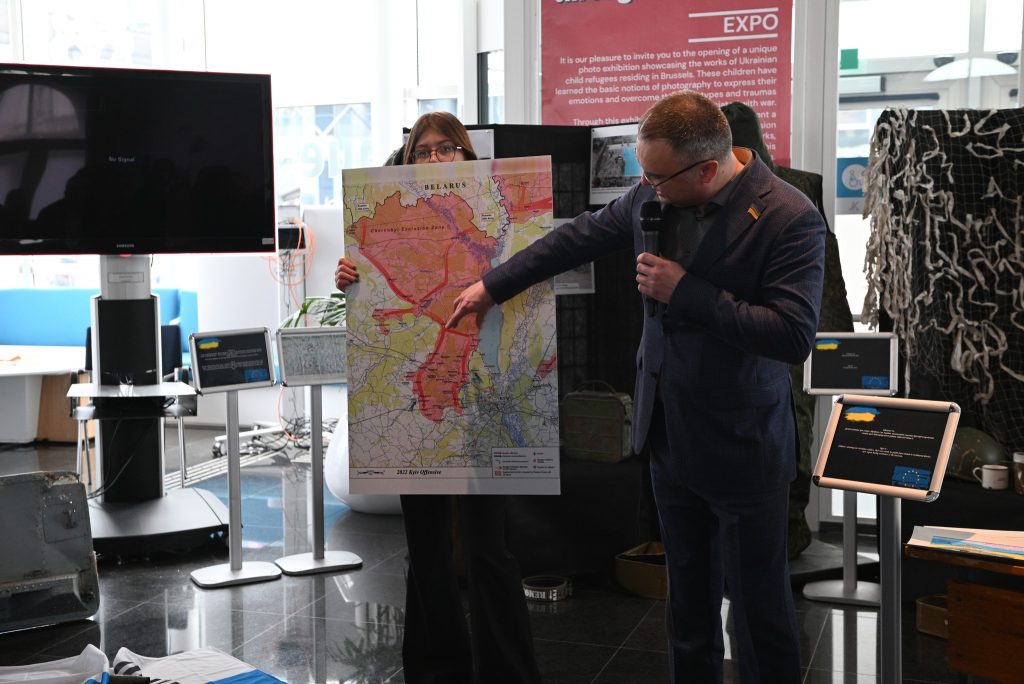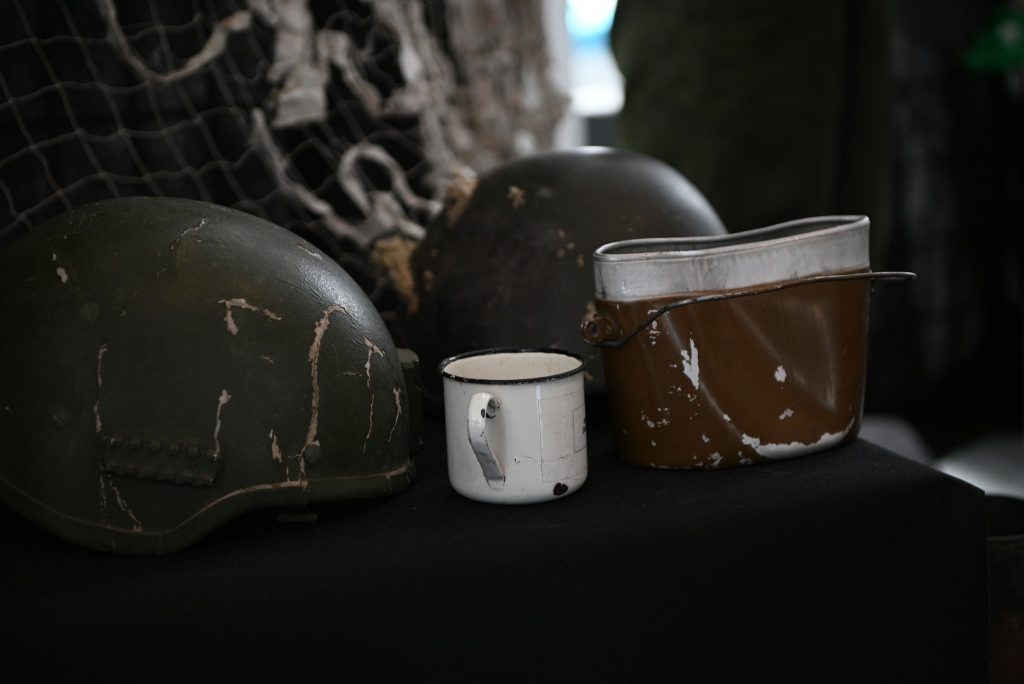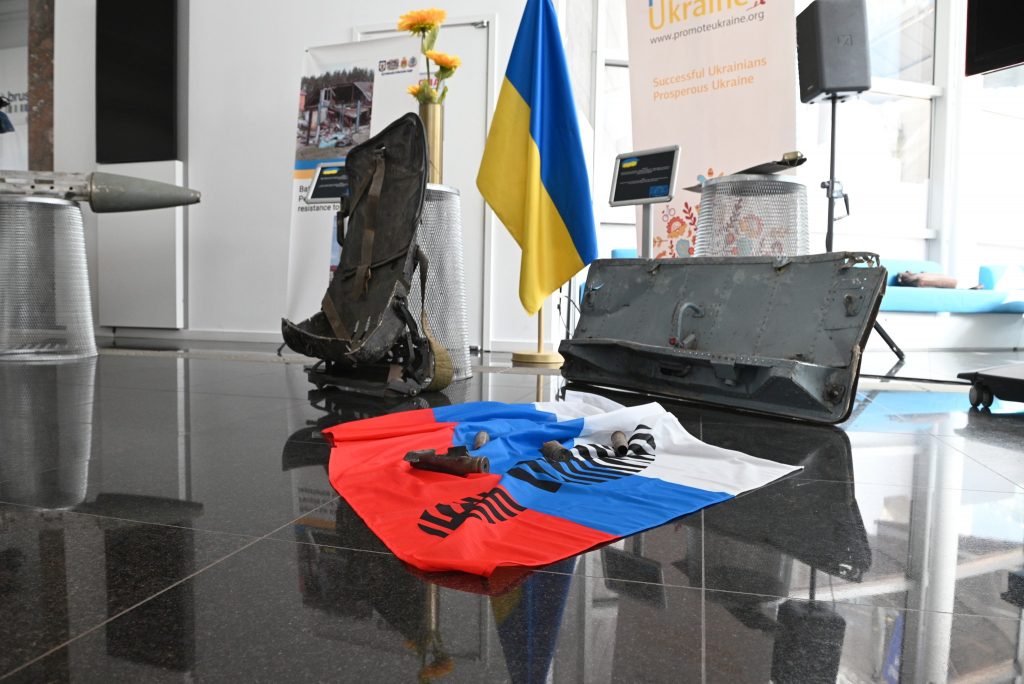In April 2023, the exhibition “Battle for Kyiv Region 2022: Resistance of People and the Armed Forces of Ukraine to the Russian Invasion” was held in Brussels, dedicated to the anniversary of the liberation of the Kyiv region from Russian invaders. During the event, everyone could see the exhibits collected by the museum staff after the de-occupation of the region: fragments of weapons, military uniforms and equipment of the Russian military, as well as photos from the battlefields in the Kyiv region. The exhibits were brought to Brussels by representatives of the local authorities of the territorial community of Petrivtsi, who, although not under occupation, suffered greatly as a result of constant shelling by Russians in March 2022. During an interview, Radion Starenkyi, the head of Petrivtsi municipality, talked about the exhibition, events in the community a year ago, and the necessity of assistance for rebuilding the damaged homes.
Thankfully, Petrivtsi municipality was not occupied, but the villages within the community faced severe damage. Could you please elaborate on what occurred during the start of the full-scale invasion?
Between February and early March 2022, we realised that due to the enemy’s rapid advancement, our villages were at risk of being attacked. Fortunately, our geographical location proved advantageous since the Irpin River, flooded by the waters of the Kyiv reservoir, had expanded, and the enemy’s attempts to cross it were unsuccessful. The Russians even built pontoon crossings, but the Ukrainian military covered them with artillery. We realised that it would be difficult for the enemy to get to us because they stood still for a month and just constantly shelled the villages. One small village in our community, Huta-Mezhyhirska, suffered greatly. From my perspective, the Russians stood no chance of reaching Kyiv, as the city was adequately prepared for any potential invasion.
During the initial days of the invasion, nearly two-thirds of the community’s population (mostly the elderly) left. Only the men who joined the territorial defense forces stayed behind in the villages. Our territorial defense forces comprised approximately 1,000 men who manned the posts and patrolled the area. Notably, on 25 February, we received our first assistance from Lithuania and Estonia, who provided us with military kits, warm clothing, and footwear. We distributed these supplies to our military and territorial defense forces.
How did you come up with the idea to create an exhibition about Russia’s invasion of the Kyiv region?

Our community is home to the “Battle for Kyiv in 1943” museum reserve, which is a state museum under the Kyiv Regional Council’s jurisdiction. We maintain constant communication with the museum and organise numerous events related to the theme of war. For me and our community, the topic of war holds immense significance. And when, at the end of March last year, the enemy was repulsed, and the Russian military finally departed from the territory of the Kyiv region, museum staff began collecting items to create new exhibits. Despite the museum mainly featuring exhibits from the 1943 battle, we decided to update the exposition and focus on the present-day war. As soon as we learned that there were already new exhibits, we were eager to discuss what happened in our area, near our community, and the hardships we endured.

Later on, we received an invitation from the Lithuanian Seimas and presented our exhibition in the country. Upon our arrival, we discovered that few representatives from local authorities interacted with parliamentary representatives from other European countries. As officials representing our community, we shared our experiences during the invasion of our region, detailing our collaboration with the military, administration, and individuals who took action. The Lithuanian leadership found it to be an extremely intriguing presentation.
Why was it important for you to hold an exhibition in Brussels?

Foremost, we would like to express our gratitude to those who help our country, and of course, tell, and show what happened. The exhibits we brought are proof of the war, although no one doubts it. But it can be interesting and useful for people to touch and see, with their own eyes, various items of weaponry and clothing.
Following the exhibition in Lithuania, we had a meeting with MEP Petras Auštrevičius. During that time, we discussed the possibility of holding a similar exhibition in Brussels, and within two months, we were able to organise it.
Would you be willing to travel to other countries with the exhibition?
Yes, of course. We are planning to conduct similar exhibitions in Germany and Poland. Our exhibition also highlights the importance of support for our community’s recovery, which is crucial to us. Unfortunately, our economic situation has deteriorated significantly due to the war. Prior to the full-scale invasion, we did not face any major issues, and our budget ranked fifth in the region in terms of financial and economic indicators. However, with the start of the Russian offensive in the Kyiv region, which also caused damage to our industrial facilities, our budget’s capacity has halved. Furthermore, we must consider the inflation rate of approximately 30%. The losses from the destruction are estimated to be around 4.5 million euros, and we cannot provide assistance to the population on our own.
How many internally displaced persons (IDPs) currently reside in your territory and require assistance in integrating into their new community?
Based on the latest estimates, there are currently around 1,760 IDPs living in our territory. The number is constantly changing as people move around. Additionally, a significant number of people from our community are still abroad. Approximately 15% of schoolchildren in our municipality are currently residing outside of the country. During the events in March 2022, only a small number of schoolchildren remained in the villages of our municipality. However, after the liberation of the Kyiv region, many people started to return.
Certainly, there are still many who remain hesitant to return, despite the reduced threat of artillery shelling, unlike the severe damage inflicted on the small village of Guta during the March 2022 events. Out of the 4.5 million euros required for the restoration of the homes of our fellow villagers, 2.5 million euros are needed specifically for the reconstruction of Guta.

* According to the information of the Petrivska village council, 175 residential buildings were partially destroyed or completely destroyed.
How can the European Union prioritise its assistance to aid in the recovery of small communities?
The primary need for the recovery of small communities is funding to repair the housing that was damaged during shelling. The residents are relying on us for help, but we cannot finance it with the local budget. The state budget is also not an option, as the army takes priority now, and our economy is only functioning at half of its pre-war productivity. While the EU and our other Western partners, including the United States, are providing assistance, the majority of the recovery efforts in our country are being carried out with the support of various international institutions and funds. Certainly, some communities with a stronger budget may be able to assist in the restoration of buildings and apartments for their residents using their own funds. However, our community lacks the financial resources to do so. Therefore, we had hoped that funding would be provided at the state level, but progress has been slow in this regard. Additionally, we would like to offer assistance to the wounded soldiers, although there are only a few in our community.
What kind of help does the military need?
Surgery and rehabilitation are essential for wounded soldiers. One serviceman from our municipality requires a surgery that costs 20,000 EUR, but unfortunately, the state cannot provide assistance at the moment.
Keeping track of the records has become challenging, so we appeal to the families of servicemen to reach out to us. We try to maintain contact with them and provide as much help as possible. During the initial months of the full-scale war, purchasing military uniforms was not feasible, as procurement was exclusively carried out by the Ministry of Defence. We could not even provide aid to our volunteer territorial defense formation. However, we started purchasing uniforms later, and even provided winter clothes to them.
In your opinion, what specific actions can an average EU citizen take to help Ukraine, especially in the coming months and years?
The main priority is to keep Ukraine in the international spotlight so that the current support from EU countries doesn’t wane. It’s crucial to maintain this level of support because the enemy is waiting for an opportunity to take advantage of any weakening in the support. Time is not on our side, as people may lose interest and become accustomed to the situation. Therefore, it’s important for people to remain interested, informed, and engaged. This should also be reflected in the policies of the European Union. Military assistance and continued sanctions are essential, as they have shown results. Without this support, we would have been unable to do much, as we would have run out of weapons early in the war. When we asked the soldiers at the front what they needed, they said they needed weapons, not just food. So, in the coming months and years, the average EU citizen can continue to support Ukraine by maintaining interest, spreading awareness, and advocating for continued support from their respective governments.
Authors: Yana Brovdiy, Kseniya Breslavska
* For more detailed information about the state of the community and the necessary assistance, please contact the Petrivtsi village council: npetrivtsi@gmail. com






 UA
UA FR
FR DE
DE




